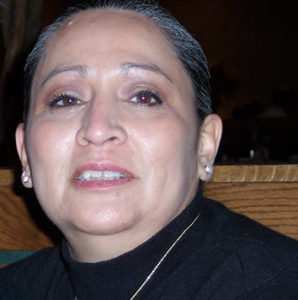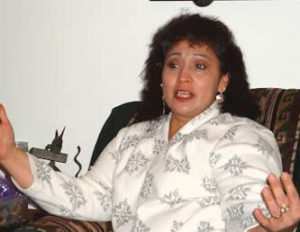LaDonna Brave Bull Allard – Oglala Lakota
 My name is Ladonna Brave Bull Allard. I’m from the Standing Rock Sioux Tribe. I live in Fort Yates North Dakota.
My name is Ladonna Brave Bull Allard. I’m from the Standing Rock Sioux Tribe. I live in Fort Yates North Dakota.
I’m a mixed-blood, so I have to tell you about both.
The Ihunktonwan from the Jamestown Valley, and so we lived in the Jamestown Valley before the White Man came. And then on the other side, the Lakota, the Hunkpapa, and the Blackfeet, they lived more west. They didn’t live on the river here. They lived out by Rock Creek, Lemon, South Dakota, in those areas, north of the Black Hills. We didn’t come towards the river until the Mandan and the Arikara were gone.
When Lewis & Clark came through this area, the Arikara and Mandan people lived here. This is their aboriginal land. Since I come from two sides – the Ihunktonwan they were more sedentary. The Upper Yankton __ people, we planted large gardens, huge fields of pumpkin and corn and squash. We didn’t have villages that moved but four times a year – summer village, winter village, hunting village – so we didn’t have the mobile village that the Lakotas did all the time. We were more sedentary. The Lakota were buffalo hunters, gatherers, but they were also farmers. There are some cases where the Ihunktonwan lived in the earth lodges that were abandoned after the Mandan died. The Lakota people, lived out on the Plains – primarily buffalo hunting, gathering – they spent a lot of time in search of buffalo, in search of deer, antelope, elk. At one time, in this area, we had bears, mountain lions, deer, antelope, and buffalo as far as the eye can see. This was a plentiful area. The other thing we had here is we had forests. We had more trees a long time ago. So life was different then.
A long time ago, the women, were in charge of the gardening but I even come across listening to old people about even the men helped. If it was too hard for them, the men would come and help. There was not this idea of that’s ‘woman’s work’ or that’s ‘man’s work’. There was kind of like that’s what women do, but if they need help the men go over there and help them. It was just like taking care of children. The men always took care of the children along with the women – it’s a shared kind of environment. The area where we’re from – the Jamestown Valley – right now the State of North Dakota holds the highest amount of burial grounds of anywhere in North Dakota of all our people.
In Lakota life, they were more mobile. They were constantly on the move. The women were in charge of putting up the tipi, taking down the tipi, making the tipi, everything inside belonged to them. If you went on a hunt, the meat belonged to the women. It’s a kind of different environment than what people live in today. The women gathered, but they also traded. The Ihunktonwan (this is a tribe name – sounds like Ihoktiwa) had a large trading network. How did they say, the Lakota were kind of like middlemen a long time ago because they would go to the Arikara and pick up corn or pumpkins and trade buffalo meat to them. Then they would go to the Mandan and say ‘well, we got these pumpkins from the Arikara’ and traded to the Mandan and the Mandan would give them different things. So there was always this trade network going on. Everybody had one family within the tribe who was responsible as a trader – who went from one place to another to trade their goods.
Then they would have these large rendezvous where they would meet. We have two of these spots here on Standing Rock where the large trading networks used to be. One would be down by Mobridge and one would be by what they call “Old Kennel” right now. That was a multipurpose trading unit there where they had Northern Cheyenne, or just Cheyenne at that time. The Cheyenne lived here at one time – then the Mandan, then the Arikara, and then the Lakota – all lived in this one spot, because it was a good place for trade. Our trading networks still exist.
We believe that dogs – the Lakota – are sacred. They are born with medicine in their bodies, and one of the things that we always tell people is like when you are a child and you fall down or hurt your knee, and the dog comes and it will lick the wound, they have a healing component in their saliva. The same with us. When we are sick, there is healing components in the dogs that will heal our bodies, and so we use that same component.
LaDonna Brave Bull Allard
 LaDonna Brave Bull Allard is the Standing Rock Tribal Tourism Coordinator for the Standing Rock Sioux Tribe and Marketing Manager for the Alliance of Tribal Tourism Advocates. She tells stories of the history of Standing Rock and her people. The stories of Sitting Bull’s life and death as well as of Lewis and Clark and Sakakawea who died on Standing Rock. She is from Cannon Ball District of Standing Rock raised in Fort Yates, North Dakota; her father was Frank Brave Bull who was descended from Tatanka Ohitika a medicine man. LaDonna graduated from the University of North Dakota with a History degree. She has been researching winter counts, and historical documents to compile her tribe history.
LaDonna Brave Bull Allard is the Standing Rock Tribal Tourism Coordinator for the Standing Rock Sioux Tribe and Marketing Manager for the Alliance of Tribal Tourism Advocates. She tells stories of the history of Standing Rock and her people. The stories of Sitting Bull’s life and death as well as of Lewis and Clark and Sakakawea who died on Standing Rock. She is from Cannon Ball District of Standing Rock raised in Fort Yates, North Dakota; her father was Frank Brave Bull who was descended from Tatanka Ohitika a medicine man. LaDonna graduated from the University of North Dakota with a History degree. She has been researching winter counts, and historical documents to compile her tribe history.
LaDonna is a national certified interpretive guide, has her own guide company, and has trained in historical preservation. She has compiled all historical information for the Standing Rock Scenic Byway. She discusses how, Lakota, Dakota, and Nakota traveled throughout North Dakota, South Dakota, Montana, Nebraska, Wyoming, Iowa, Missouri, Wisconsin, Saskatchewan, and Manitoba as a major entity on the plain. Her past lecture has been on 500 years of oppression, Native American Women, the History of the Standing Rock Sioux tribe, and the notorious history of Standing Rock.
LaDonna eloquently discusses with diverse audiences information about her tribe’s 2.3 million acres of land, where there is still native grass, plants, migrating birds, and native medicines that are needed for everyday use. Today, the Standing Rock Sioux Tribe has four bands of the Nakota/Dakota and Lakota and is located at the central border of North and South Dakota. LaDonna Allard has been recorded for Wisdom of the Elders Radio at www.wisdomoftheelders.org ( Series Two – Program Three – Historical Intro).
LaDonna Brave Bull Allard
168-3 River Road
PO Box 670
Fort Yates, ND 58538
(701) 854-7695 home
(701)-854-8500 x186 work
LadonnaBrave1@aol.com
http://standingrocktourism.com
